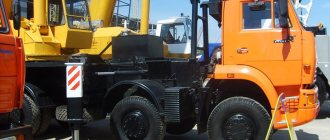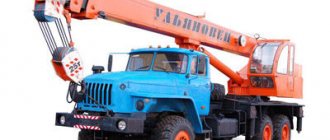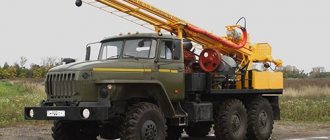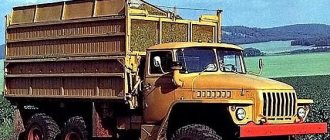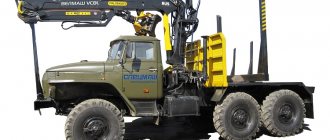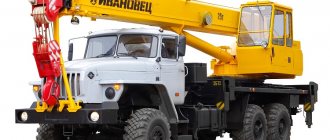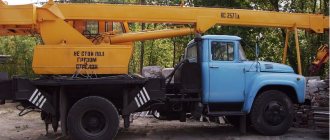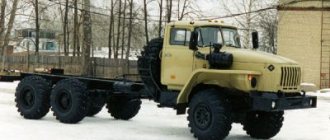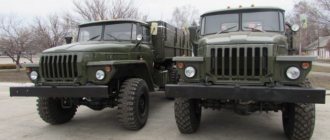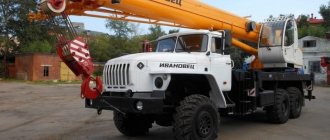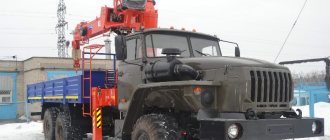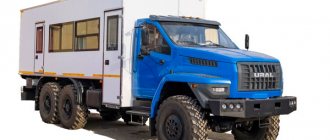Ural cars from the Chelyabinsk Machine-Building Plant have been known since the times of the Soviet Union. At first, they were created as army trucks, so the chassis of these vehicles was designed to withstand exorbitant loads and travel on almost absolute off-road conditions. According to reviews of military personnel who served in “hot spots” in all geographical latitudes, the Ural is one of the most passable and unpretentious vehicles to operate.
During the conversion process, military vehicles became civilian ones, but, as happened with many vehicles, they did not lose their qualities. They were skillfully converted for household needs. Modifications of the Ural with a diesel engine have become the base vehicle for more than 400 industrial installations.
Specifications
Chassis 43203 is a modification of model 4320 with an increased mounting base. It can carry cargo or superstructure weighing about 7 tons. In this case, the load on the front axle should not exceed 5300 kg. When installing the mechanism on the platform, this parameter must be taken into account.
Manipulator cranes based on the Ural are equipped with a standard 230 hp engine. In the design production version it is a turbodiesel. By special order, the engine can be installed with higher power - up to 250 hp.
The gearbox is a five-speed with a transfer case and is coupled with a center differential equipped with a lock. The total vehicle weight is 21,300 kg, excluding add-ons and installed units. Weight distribution - 5300 kg on the front axle, 16000 kg on the rear bogie. The steering is hydromechanical, only the front wheels turn.
| Load capacity | 12000 kg |
| Full mass | 21300 kg |
| Power | 230 l. With. |
| engine's type | diesel turbocharged |
| Engine capacity | 11.15 cc |
| Fuel tank, volume | 300 +210 l |
| checkpoint | mechanical |
| Wheelbase | 4555+1400 mm |
| Suspension (front/rear) | spring |
| Brakes (front/rear) | drums |
| Tires | 425x80/R21 |
Chassis description
There are many chassis options on which cranes can be mounted, which allows you to select equipment with optimal technical characteristics. The following types of Ural cars are most often used as a basis:
- 4320;
- 5557;
- Next
The 4320 is the basic option used to accommodate most truck cranes from various brands. Provides a fuel tank of 300 liters, which allows you to work for a long time without the need to refuel.
Be sure to read: Characteristics of the KKS-10 gantry crane
Models based on 5557 are most often used when performing various construction works, as well as for transporting goods. This product has low operating costs, which is why it is widely used by various government services, for example, the Ministry of Emergency Situations.
Ural Next is significantly superior to most of its analogues, since it is a new development of the automaker. It is equipped with a two-row cabin designed for 7 people, which makes it the optimal vehicle for work crews involved in construction or installation work. For vehicles of the Chelyabinets brand, chassis 63685 is also often used, which is somewhat different from standard analogues. For units produced under the “Galichanin” brand, 6563 is also often used.
The chassis, manufactured under number 63685, is distinguished by its affordable price and high level of reliability, allowing it to be used for solving various tasks. Despite the mediocre level of comfort in the operator's cabin, the model is able to effectively compete with the products of foreign concerns.
The 6563 is also a reliable basis for a truck crane, as it differs from its analogues in its 8x4 wheel arrangement, as well as the location of the cabin above the engine, which makes travel on rough roads more comfortable.
Manipulators Ural
For various lifting operations, a crane manipulator based on the Urals is one of the most popular devices in construction sites, forestry and other areas of economic activity where access roads are far from perfect. The three-axle 6x6 chassis allows you to reach any object.
Ural with manipulator crane IM 240-04 can work with any type of load gripper. The lift consists of four retractable hydraulic sections. The maximum lifting capacity of the installation is 7000 kg with a boom reach of 12 meters. At maximum reach, the crane installation can lift a load of 1.7 tons to a height of up to 14 meters. If the load needs to be lowered below the axis of the machine, the lowering depth is up to 9.5 meters. The hydraulic boom is controlled from the ground using a remote control, or from the seat equipped with the lifting unit.
To maintain balance, the Ural crane manipulator is equipped with retractable hydraulic stops. The support base is 5890 mm.
Based on the Ural 4320 vehicle, the Swedish-Russian joint venture is installing a HIAB 288 EP-3 HiDuo crane manipulator equipped with an operator station. This is a powerful unit with a telescopic boom with a lifting capacity of 8.6 tons. The maximum boom reach is 22.4 meters with a load moment of 20 tons per meter. At maximum boom reach in a horizontal position, the crane manipulator can lift a load of about 500 kg.
The multifunctional crane manipulator on the Ural chassis is designed to work in difficult conditions with temperature ranges from – 50 to + 45 ° C. The vehicle's chassis allows it to go where any truck would stop. Therefore, these machines are indispensable in logging sites, pipeline routes, drilling sites, field camps and new buildings.
The total weight of the crane installation is 3.7 tons, the height in transport condition is 2.4 meters. In combination with an on-board vehicle, a multifunctional crane manipulator on the Ural chassis can overcome unevenness up to 60°, while the balance of the crane installation is not disturbed.
Manipulator cranes based on Ural4320 and 43203 are indispensable machines in extreme climates. Even in mid-latitude weather conditions, which are becoming increasingly common, these installations are unique for use in emergency situations and everyday work.
In most cases, the MKM-200 CMU is installed on such a model, however, the options do not end there.
More information about the equipment of the crew bus interior
The frame-metal van body with thermal insulation is equipped with double passenger seats for 20 people, with seat belts. On one side, these seats are attached to the wall of the rotation bus, and on the other, to its floor, through a special support leg. This allows you to free up space under the seats for easier and better cleaning of the crew bus interior. The seat cushion is quite wide, the backrests are anatomically shaped and equipped with headrests integrated into them. The seat upholstery is made of frost-resistant artificial leather, it is durable and practical.
Windows, at the request of the customer, can be made of double sealed double glazing of safety glass, with a seal 60 mm thick. All windows in the cabin of the rotation bus are equipped with sun blinds.
The floor of the van is made of bakelized plywood, waterproof, and insulated with high-density polystyrene foam of 30-millimeter thickness. They are also covered with high-strength multilayer polymer coatings that have an anti-slip effect. The cutting of this floor covering is specially designed for as few joints as possible. All its connections to the walls are made without joints - with smooth transitions to the walls, for impeccable waterproofing and ease of cleaning in the cabin.
Important How to make a car scissor lift with your own hands
The insulation of the walls and ceiling of the van is carried out using extruded XPS polystyrene foam with a thickness of 60 mm. When attaching the inner lining to the frame, a 20-mm thick heat insulator is used for better thermal insulation. The interior lining of the cabin is made of automotive PVC plastic, which is not subject to temperature changes and is not afraid of increased air humidity. Any dirt can be removed from such a coating quite easily, and minor mechanical damage will not spoil the appearance of the interior.
The autonomous air heater in the Ural cabin 32551-0010-41 is equipped with 2 independent heating circuits. In cases of failure of the main circuit (from the cooling system of a diesel engine of a car), an additional one is activated, operating in autonomous mode, using diesel fuel. This heater is controlled by an automatic electronic unit located in the cabin of the rotation bus (but it can also be installed in the driver’s cabin).
24-volt voltage is constantly supplied from the vehicle's electrical circuit. The cabin of the rotation bus is equipped with the required number of ceiling dust- and moisture-proof lamps (fluorescent). The car is equipped with a cabin-loudspeaker intercom.
Characteristics of the crane-manipulator MKM-200
| Telescopic boom reach, m: maximum: | 9,60 |
| Telescopic boom reach, m: minimum: | 1,32 |
| Boom lifting angle from horizontal, degrees: | 70 |
| Boom lowering angle from horizontal, degrees: | 30 |
| Column rotation angle, degrees: | 320 |
| Maximum torque on the drilling tool, kN*m: | 6,7 |
| Drilling diameter with standard auger, m: | 0.36 or 0.5 |
| Drilling depth with standard auger, m: | no more than 4.2 |
| Drilling depth with auger extension, m: | no more than 8 |
| Maximum reach during drilling, m: | 5,4 |
| Minimum reach when drilling, m: | 3,2 |
| Maximum load force on the working tool, kN: | 50 |
| Load moment, tm: | 14,8 |
| Load capacity at maximum reach, t: | 1,2 |
| Load capacity at minimum reach, t: | 4,0 |
| Loading capacity of the telescopic lift cradle, kg: | 250 |
| Maximum lifting height of the telescopic lift cradle, m: | 13,3 |
| Lift working sector, degrees: | 180 |
| Overall dimensions: length, width, height, mm: | 8900x2550x3900 |
| Basic chassis: | Ural 4320-0111-41 |
| Weight of transported cargo, tons: | 4,3 |
The drilling rig can produce holes with a diameter of up to 0.5 meters to a depth of 8 meters if an extended auger is used. The hydraulic drill develops a torque of 630 kilograms.
The transport capabilities of the vehicle are preserved - the body can carry loads weighing up to 4.3 tons. At maximum boom reach, the crane mechanism can lift up to 1.2 tons of cargo, and at minimum - 4 tons.
All working and auxiliary movements of the installation are carried out by hydraulic cylinders and hydraulic motors, which can be controlled from a remote control located near the crane column or from a remote control, which you can even take with you to the cradle for high-altitude work.
